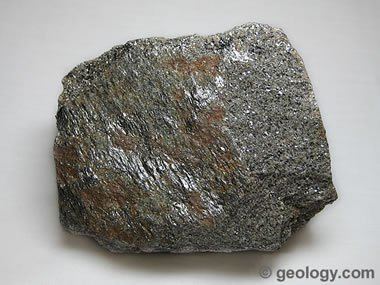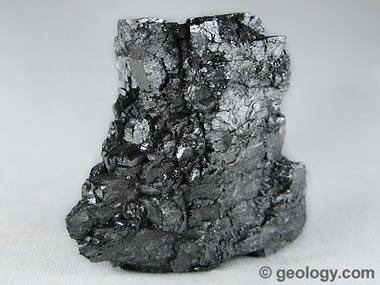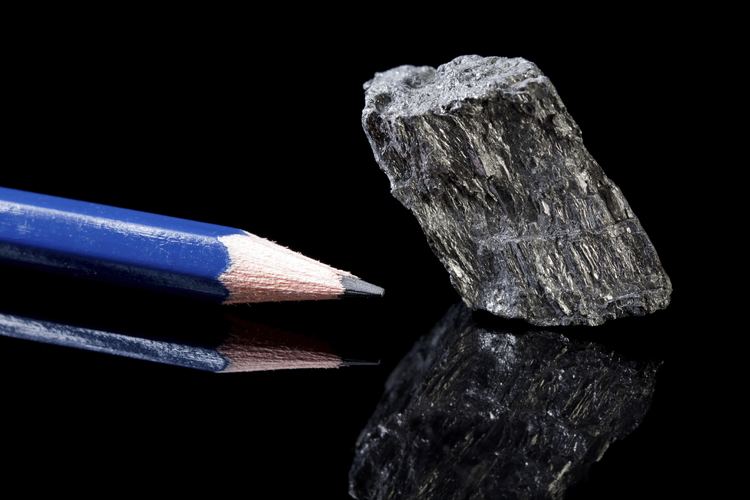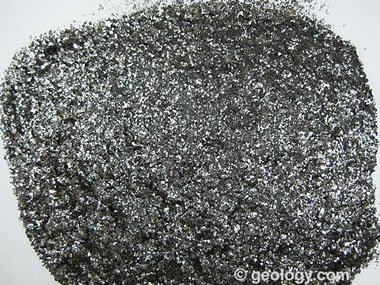Category Native mineral Strunz classification 1.CB.05a Space group P63/mmc | Formula(repeating unit) C Crystal system Hexagonal | |
Crystal class Dihexagonal dipyramidal (6mmm)H-M symbol: (6/m 2/m 2/m) | ||
Graphite and its awesome properties
Graphite ( /ˈɡræfaɪt/), archaically referred to as plumbago, is a crystalline form of carbon, a semimetal, a native element mineral, and one of the allotropes of carbon. Graphite is the most stable form of carbon under standard conditions. Therefore, it is used in thermochemistry as the standard state for defining the heat of formation of carbon compounds.
Contents
- Graphite and its awesome properties
- Structure of diamond and graphite
- Types and varieties
- Occurrence
- Structure
- Other properties
- History of natural graphite use
- Other names
- Uses of natural graphite
- Refractories
- Batteries
- Steelmaking
- Brake linings
- Foundry facings and lubricants
- Pencils
- Other uses
- Expanded graphite
- Intercalated graphite
- Invention of a process to produce synthetic graphite
- Scientific research
- Electrodes
- Powder and scrap
- Neutron moderator
- Graphite mining beneficiation and milling
- Occupational safety
- United States
- Graphite recycling
- References

Structure of diamond and graphite
Types and varieties
There are three principal types of natural graphite, each occurring in different types of ore deposits:

Occurrence

Graphite occurs in metamorphic rocks as a result of the reduction of sedimentary carbon compounds during metamorphism. It also occurs in igneous rocks and in meteorites. Minerals associated with graphite include quartz, calcite, micas and tourmaline. In meteorites it occurs with troilite and silicate minerals. Small graphitic crystals in meteoritic iron are called cliftonite.

According to the United States Geological Survey (USGS), world production of natural graphite in 2012 was 1,100,000 tonnes, of which the following major exporters are: China (750 kt), India (150 kt), Brazil (75 kt), North Korea (30 kt) and Canada (26 kt). Graphite is not mined in the United States, but U.S. production of synthetic graphite in 2010 was 134 kt valued at $1.07 billion.
Structure
Graphite has a layered, planar structure. The individual layers are called graphene. In each layer, the carbon atoms are arranged in a honeycomb lattice with separation of 0.142 nm, and the distance between planes is 0.335 nm. Atoms in the plane are bonded covalently, with only three of the four potential bonding sites satisfied. The fourth electron is free to migrate in the plane, making graphite electrically conductive. However, it does not conduct in a direction at right angles to the plane. Bonding between layers is via weak van der Waals bonds, which allows layers of graphite to be easily separated, or to slide past each other.
The two known forms of graphite, alpha (hexagonal) and beta (rhombohedral), have very similar physical properties, except for that the graphene layers stack slightly differently. The alpha graphite may be either flat or buckled. The alpha form can be converted to the beta form through mechanical treatment and the beta form reverts to the alpha form when it is heated above 1300 °C.
Other properties
The acoustic and thermal properties of graphite are highly anisotropic, since phonons propagate quickly along the tightly-bound planes, but are slower to travel from one plane to another. Graphite's high thermal stability and electrical and thermal conductivity facilitate its widespread use as electrodes and refractories in high temperature material processing applications. However, in oxygen containing atmospheres graphite readily oxidizes to form CO2 at temperatures of 700 °C and above.
Graphite is an electric conductor, consequently, useful in such applications as arc lamp electrodes. It can conduct electricity due to the vast electron delocalization within the carbon layers (a phenomenon called aromaticity). These valence electrons are free to move, so are able to conduct electricity. However, the electricity is primarily conducted within the plane of the layers. The conductive properties of powdered graphite allows its use as pressure sensor in carbon microphones.
Graphite and graphite powder are valued in industrial applications for their self-lubricating and dry lubricating properties. There is a common belief that graphite's lubricating properties are solely due to the loose interlamellar coupling between sheets in the structure. However, it has been shown that in a vacuum environment (such as in technologies for use in space), graphite degrades as a lubricant, due to the hypoxic conditions This observation led to the hypothesis that the lubrication is due to the presence of fluids between the layers, such as air and water, which are naturally adsorbed from the environment. This hypothesis has been refuted by studies showing that air and water are not absorbed. Recent studies suggest that an effect called superlubricity can also account for graphite's lubricating properties. The use of graphite is limited by its tendency to facilitate pitting corrosion in some stainless steel, and to promote galvanic corrosion between dissimilar metals (due to its electrical conductivity). It is also corrosive to aluminium in the presence of moisture. For this reason, the US Air Force banned its use as a lubricant in aluminium aircraft, and discouraged its use in aluminium-containing automatic weapons. Even graphite pencil marks on aluminium parts may facilitate corrosion. Another high-temperature lubricant, hexagonal boron nitride, has the same molecular structure as graphite. It is sometimes called white graphite, due to its similar properties.
When a large number of crystallographic defects bind these planes together, graphite loses its lubrication properties and becomes what is known as pyrolytic graphite. It is also highly anisotropic, and diamagnetic, thus it will float in mid-air above a strong magnet. If it is made in a fluidized bed at 1000–1300 °C then it is isotropic turbostratic, and is used in blood contacting devices like mechanical heart valves and is called pyrolytic carbon, and is not diamagnetic. Pyrolytic graphite, and pyrolytic carbon are often confused but are very different materials.
Natural and crystalline graphites are not often used in pure form as structural materials, due to their shear-planes, brittleness and inconsistent mechanical properties.
History of natural graphite use
In the 4th millennium B.C., during the Neolithic Age in southeastern Europe, the Mariţa culture used graphite in a ceramic paint for decorating pottery.
Some time before 1565 (some sources say as early as 1500), an enormous deposit of graphite was discovered on the approach to Grey Knotts from the hamlet of Seathwaite in Borrowdale parish, Cumbria, England, which the locals found very useful for marking sheep. During the reign of Elizabeth I (1533–1603), Borrowdale graphite was used as a refractory material to line moulds for cannonballs, resulting in rounder, smoother balls that could be fired farther, contributing to the strength of the English navy. This particular deposit of graphite was extremely pure and soft, and could easily be cut into sticks. Because of its military importance, this unique mine and its production were strictly controlled by the Crown.
Other names
Historically, graphite was called black lead or plumbago. Plumbago was commonly used in its massive mineral form. Both of these names arise from confusion with the similar-appearing lead ores, particularly galena. The Latin word for lead, plumbum, gave its name to the English term for this grey metallic-sheened mineral and even to the leadworts or plumbagos, plants with flowers that resemble this colour.
The term black lead usually refers to a powdered or processed graphite, matte black in color.
Abraham Gottlob Werner coined the name graphite ("writing stone") in 1789. He attempted to clear up the confusion between molybdena, plumbago and blacklead after Carl Wilhelm Scheele in 1778 proved that there are at least three different minerals. Scheele's analysis showed that the chemical compounds molybdenum sulfide (molybdenite), lead(II) sulfide (galena) and graphite were three different soft black minerals.
Uses of natural graphite
Natural graphite is mostly consumed for refractories, batteries, steelmaking, expanded graphite, brake linings, foundry facings and lubricants. Graphene, which occurs naturally in graphite, has unique physical properties and is among the strongest substances known. However, the process of separating it from graphite will require more technological development.
Refractories
The use of graphite as a refractory material began before 1900 with the graphite crucible used to hold molten metal; this is now a minor part of refractories. In the mid-1980s, the carbon-magnesite brick became important, and a bit later the alumina-graphite shape. As of 2017 the order of importance is: alumina-graphite shapes, carbon-magnesite brick, monolithics (gunning and ramming mixes), and then crucibles.
Crucibles began using very large flake graphite, and carbon-magnesite brick requiring not quite so large flake graphite; for these and others there is now much more flexibility in size of flake required, and amorphous graphite is no longer restricted to low-end refractories. Alumina-graphite shapes are used as continuous casting ware, such as nozzles and troughs, to convey the molten steel from ladle to mold, and carbon magnesite bricks line steel converters and electric-arc furnaces to withstand extreme temperatures. Graphite blocks are also used in parts of blast furnace linings where the high thermal conductivity of the graphite is critical. High-purity monolithics are often used as a continuous furnace lining instead of carbon-magnesite bricks.
The US and European refractories industry had a crisis in 2000–2003, with an indifferent market for steel and a declining refractory consumption per tonne of steel underlying firm buyouts and many plant closures. Many of the plant closures resulted from the acquisition of Harbison-Walker Refractories by RHI AG and some plants had their equipment auctioned off. Since much of the lost capacity was for carbon-magnesite brick, graphite consumption within the refractories area moved towards alumina-graphite shapes and monolithics, and away from brick. The major source of carbon-magnesite brick is now imports from China. Almost all of the above refractories are used to make steel and account for 75% of refractory consumption; the rest is used by a variety of industries, such as cement.
According to the USGS, US natural graphite consumption in refractories comprised 12,500 tonnes in 2010.
Batteries
The use of graphite in batteries has been increasing in the last 30 years. Natural and synthetic graphite are used to construct the anode of all major battery technologies. The lithium-ion battery utilizes roughly twice the amount of graphite than lithium carbonate.
The demand for batteries, primarily nickel-metal-hydride and lithium-ion batteries, has caused a growth in graphite demand in the late 1980s and early 1990s. This growth was driven by portable electronics, such as portable CD players and power tools. Laptops, mobile phones, tablet, and smartphone products have increased the demand for batteries. Electric vehicle batteries are anticipated to increase graphite demand. As an example, a lithium-ion battery in a fully electric Nissan Leaf contains nearly 40 kg of graphite.
Steelmaking
Natural graphite in this end use mostly goes into carbon raising in molten steel, although it can be used to lubricate the dies used to extrude hot steel. Supplying carbon raisers is very competitive, therefore subject to cut-throat pricing from alternatives such as synthetic graphite powder, petroleum coke, and other forms of carbon. A carbon raiser is added to increase the carbon content of the steel to the specified level. An estimate based on USGS US graphite consumption statistics indicates that 10,500 tonnes were used in this fashion in 2005.
Brake linings
Natural amorphous and fine flake graphite are used in brake linings or brake shoes for heavier (nonautomotive) vehicles, and became important with the need to substitute for asbestos. This use has been important for quite some time, but nonasbestos organic (NAO) compositions are beginning to reduce graphite's market share. A brake-lining industry shake-out with some plant closures has not been beneficial, nor has an indifferent automotive market. According to the USGS, US natural graphite consumption in brake linings was 6,510 tonnes in 2005.
Foundry facings and lubricants
A foundry facing mold wash is a water-based paint of amorphous or fine flake graphite. Painting the inside of a mold with it and letting it dry leaves a fine graphite coat that will ease separation of the object cast after the hot metal has cooled. Graphite lubricants are specialty items for use at very high or very low temperatures, as forging die lubricant, an antiseize agent, a gear lubricant for mining machinery, and to lubricate locks. Having low-grit graphite, or even better no-grit graphite (ultra high purity), is highly desirable. It can be used as a dry powder, in water or oil, or as colloidal graphite (a permanent suspension in a liquid). An estimate based on USGS graphite consumption statistics indicates that 2,200 tonnes was used in this fashion in 2005.
Pencils
The ability to leave marks on paper and other objects gave graphite its name, given in 1789 by German mineralogist Abraham Gottlob Werner. It stems from graphein, meaning to write/draw in Ancient Greek.
From the 16th Century, pencils were made with leads of English natural graphite, but modern pencil lead is most commonly a mix of powdered graphite and clay; it was invented by Nicolas-Jacques Conté in 1795. It is chemically unrelated to the metal lead, whose ores had a similar appearance, hence the continuation of the name. Plumbago is another older term for natural graphite used for drawing, typically as a lump of the mineral without a wood casing. The term plumbago drawing is normally restricted to 17th and 18th century works, mostly portraits.
Today, pencils are still a small but significant market for natural graphite. Around 7% of the 1.1 million tonnes produced in 2011 was used to make pencils. Low-quality amorphous graphite is used and sourced mainly from China.
Other uses
Natural graphite has found uses in zinc-carbon batteries, in electric motor brushes, and various specialized applications. Graphite of various hardness or softness results in different qualities and tones when used as an artistic medium. Railroads would often mix powdered graphite with waste oil or linseed oil to create a heat-resistant protective coating for the exposed portions of a steam locomotive's boiler, such as the smokebox or lower part of the firebox.
Expanded graphite
Expanded graphite is made by immersing natural flake graphite in a bath of chromic acid, then concentrated sulfuric acid, which forces the crystal lattice planes apart, thus expanding the graphite. The expanded graphite can be used to make graphite foil or used directly as "hot top" compound to insulate molten metal in a ladle or red-hot steel ingots and decrease heat loss, or as firestops fitted around a fire door or in sheet metal collars surrounding plastic pipe (during a fire, the graphite expands and chars to resist fire penetration and spread), or to make high-performance gasket material for high-temperature use. After being made into graphite foil, the foil is machined and assembled into the bipolar plates in fuel cells. The foil is made into heat sinks for laptop computers which keeps them cool while saving weight, and is made into a foil laminate that can be used in valve packings or made into gaskets. Old-style packings are now a minor member of this grouping: fine flake graphite in oils or greases for uses requiring heat resistance. A GAN estimate of current US natural graphite consumption in this end use is 7,500 tonnes.
Intercalated graphite
Graphite forms intercalation compounds with some metals and small molecules. In these compounds, the host molecule or atom gets "sandwiched" between the graphite layers, resulting in a type of compounds with variable stoichiometry. A prominent example of an intercalation compound is potassium graphite, denoted by the formula KC8. Graphite intercalation compounds are superconductors. The highest transition temperature (by June 2009) Tc = 11.5 K is achieved in CaC6, and it further increases under applied pressure (15.1 K at 8 GPa).
Invention of a process to produce synthetic graphite
In 1893 Charles Street of Le Carbone discovered a process for making artificial graphite. Another process to make synthetic graphite was invented accidentally by Edward Goodrich Acheson (1856–1931). In the mid-1890s, Acheson discovered that overheating carborundum produced almost pure graphite. While studying the effects of high temperature on carborundum, he had found that silicon vaporizes at about 4,150 °C (7,500 °F), leaving the carbon behind in graphitic carbon. This graphite was another major discovery for him, and it became extremely valuable and helpful as a lubricant.
In 1896 Acheson received a patent for his method of synthesizing graphite, and in 1897 started commercial production. The Acheson Graphite Co. was formed in 1899.
Scientific research
Highly oriented pyrolytic graphite (HOPG) is the highest-quality synthetic form of graphite. It is used in scientific research, in particular, as a length standard for scanner calibration of scanning probe microscope.
Electrodes
Graphite electrodes carry the electricity that melts scrap iron and steel, and sometimes direct-reduced iron (DRI), in electric arc furnaces, which are the vast majority of steel furnaces. They are made from petroleum coke after it is mixed with coal tar pitch. They are then extruded and shaped, baked to carbonize the binder (pitch), and finally graphitized by heating it to temperatures approaching 3000 °C, at which the carbon atoms arrange into graphite. They can vary in size up to 11 feet long and 30 inches in diameter. An increasing proportion of global steel is made using electric arc furnaces, and the electric arc furnace itself is getting more efficient, making more steel per tonne of electrode. An estimate based on USGS data indicates that graphite electrode consumption was 197,000 tonnes in 2005.
Electrolytic aluminium smelting also uses graphitic carbon electrodes. On a much smaller scale, synthetic graphite electrodes are used in electrical discharge machining (EDM), commonly to make injection molds for plastics.
Powder and scrap
The powder is made by heating powdered petroleum coke above the temperature of graphitization, sometimes with minor modifications. The graphite scrap comes from pieces of unusable electrode material (in the manufacturing stage or after use) and lathe turnings, usually after crushing and sizing. Most synthetic graphite powder goes to carbon raising in steel (competing with natural graphite), with some used in batteries and brake linings. According to the USGS, US synthetic graphite powder and scrap production was 95,000 tonnes in 2001 (latest data).
Neutron moderator
Special grades of synthetic graphite, such as Gilsocarbon, also find use as a matrix and neutron moderator within nuclear reactors. Its low neutron cross-section also recommends it for use in proposed fusion reactors. Care must be taken that reactor-grade graphite is free of neutron absorbing materials such as boron, widely used as the seed electrode in commercial graphite deposition systems—this caused the failure of the Germans' World War II graphite-based nuclear reactors. Since they could not isolate the difficulty they were forced to use far more expensive heavy water moderators. Graphite used for nuclear reactors is often referred to as nuclear graphite.
Other uses
Graphite (carbon) fiber and carbon nanotubes are also used in carbon fiber reinforced plastics, and in heat-resistant composites such as reinforced carbon-carbon (RCC). Commercial structures made from carbon fiber graphite composites include fishing rods, golf club shafts, bicycle frames, sports car body panels, the fuselage of the Boeing 787 Dreamliner and pool cue sticks and have been successfully employed in reinforced concrete, The mechanical properties of carbon fiber graphite-reinforced plastic composites and grey cast iron are strongly influenced by the role of graphite in these materials. In this context, the term "(100%) graphite" is often loosely used to refer to a pure mixture of carbon reinforcement and resin, while the term "composite" is used for composite materials with additional ingredients.
Modern smokeless powder is coated in graphite to prevent the buildup of static charge.
Graphite has been used in at least three radar absorbent materials. It was mixed with rubber in Sumpf and Schornsteinfeger, which were used on U-boat snorkels to reduce their radar cross section. It was also used in tiles on early F-117 Nighthawk (1983)s.
Graphite mining, beneficiation, and milling
Graphite is mined by both open pit and underground methods. Graphite usually needs beneficiation. This may be carried out by hand-picking the pieces of gangue (rock) and hand-screening the product or by crushing the rock and floating out the graphite. Beneficiation by flotation encounters the difficulty that graphite is very soft and "marks" (coats) the particles of gangue. This makes the "marked" gangue particles float off with the graphite, yielding impure concentrate. There are two ways of obtaining a commercial concentrate or product: repeated regrinding and floating (up to seven times) to purify the concentrate, or by acid leaching (dissolving) the gangue with hydrofluoric acid (for a silicate gangue) or hydrochloric acid (for a carbonate gangue).
In milling, the incoming graphite products and concentrates can be ground before being classified (sized or screened), with the coarser flake size fractions (below 8 mesh, 8–20 mesh, 20–50 mesh) carefully preserved, and then the carbon contents are determined. Some standard blends can be prepared from the different fractions, each with a certain flake size distribution and carbon content. Custom blends can also be made for individual customers who want a certain flake size distribution and carbon content. If flake size is unimportant, the concentrate can be ground more freely. Typical end products include a fine powder for use as a slurry in oil drilling and coatings for foundry molds, carbon raiser in the steel industry (Synthetic graphite powder and powdered petroleum coke can also be used as carbon raiser). Environmental impacts from graphite mills consist of air pollution including fine particulate exposure of workers and also soil contamination from powder spillages leading to heavy metal contamination of soil.
Occupational safety
People can be exposed to graphite in the workplace by breathing it in, skin contact, and eye contact.
United States
The Occupational Safety and Health Administration (OSHA) has set the legal limit (permissible exposure limit) for graphite exposure in the workplace as a time weighted average (TWA) of 15 million particles per cubic foot (1.5 mg/m3) over an 8-hour workday. The National Institute for Occupational Safety and Health (NIOSH) has set a recommended exposure limit (REL) of TWA 2.5 mg/m3 respirable dust over an 8-hour workday. At levels of 1250 mg/m3, graphite is immediately dangerous to life and health.
Graphite recycling
The most common way of recycling graphite occurs when synthetic graphite electrodes are either manufactured and pieces are cut off or lathe turnings are discarded, or the electrode (or other) are used all the way down to the electrode holder. A new electrode replaces the old one, but a sizeable piece of the old electrode remains. This is crushed and sized, and the resulting graphite powder is mostly used to raise the carbon content of molten steel. Graphite-containing refractories are sometimes also recycled, but often not because of their graphite: the largest-volume items, such as carbon-magnesite bricks that contain only 15–25% graphite, usually contain too little graphite. However, some recycled carbon-magnesite brick is used as the basis for furnace-repair materials, and also crushed carbon-magnesite brick is used in slag conditioners. While crucibles have a high graphite content, the volume of crucibles used and then recycled is very small.
A high-quality flake graphite product that closely resembles natural flake graphite can be made from steelmaking kish. Kish is a large-volume near-molten waste skimmed from the molten iron feed to a basic oxygen furnace, and consists of a mix of graphite (precipitated out of the supersaturated iron), lime-rich slag, and some iron. The iron is recycled on site, leaving a mixture of graphite and slag. The best recovery process uses hydraulic classification (which utilizes a flow of water to separate minerals by specific gravity: graphite is light and settles nearly last) to get a 70% graphite rough concentrate. Leaching this concentrate with hydrochloric acid gives a 95% graphite product with a flake size ranging from 10 mesh down.
